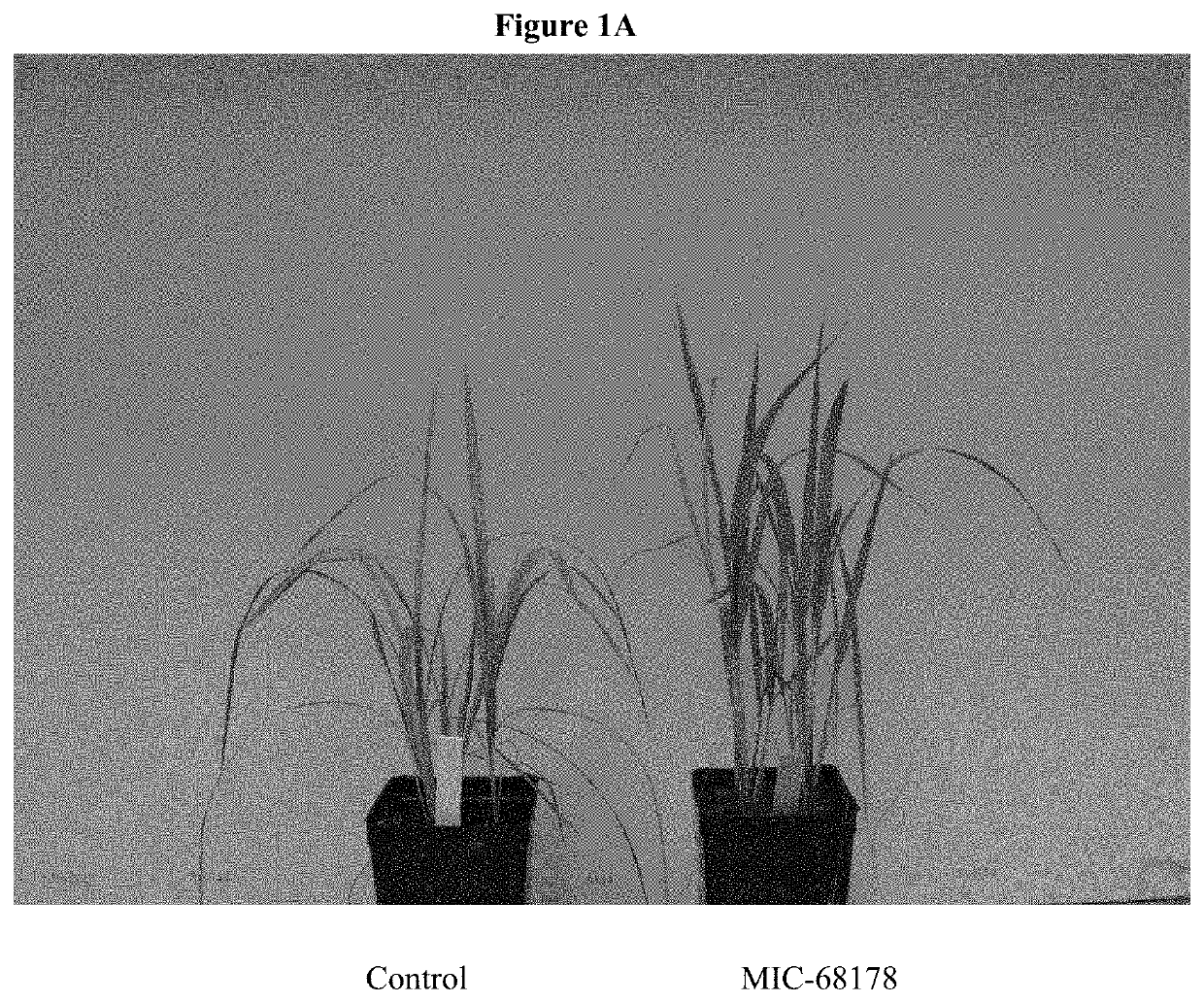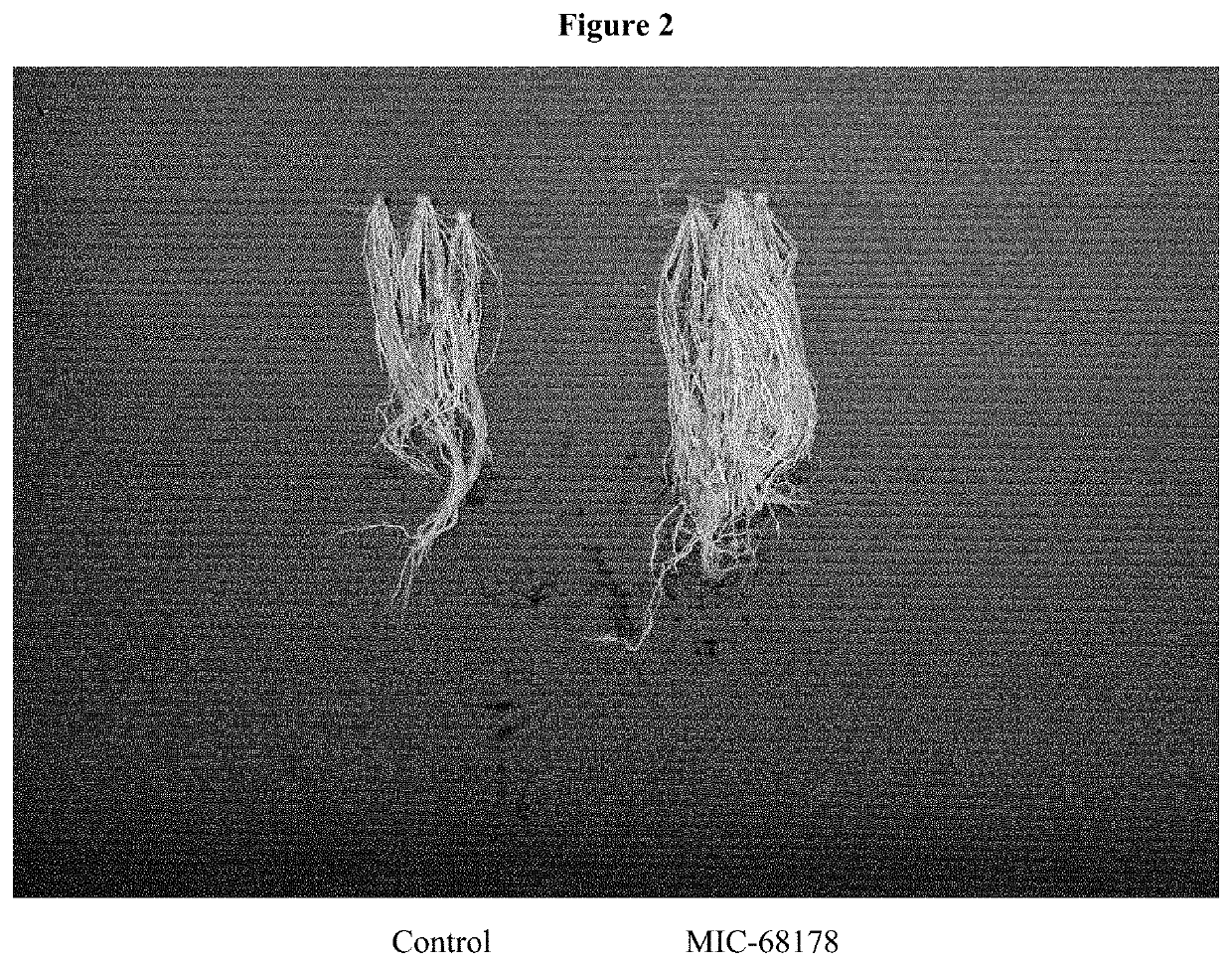Endophyte compositions and methods for improvement of plant traits
a technology of endophyte and composition, applied in the field of endophyte composition and methods for improving plant traits, can solve the problems of many gm traits that cannot be accepted by many global markets, and many synthetic chemistries are excluded from some global markets, so as to increase yield and yield
- Summary
- Abstract
- Description
- Claims
- Application Information
AI Technical Summary
Benefits of technology
Problems solved by technology
Method used
Image
Examples
example 1
and Identification of Endophytes
[0351]Isolation and cultivation of endophytic microbes from agricultural plants was performed using methods well known in the art. DNA was extracted from the ground tissues using the DNeasy DNA extraction kit (Qiagen, Hilden, Germany) according to the manufacturer's instructions. The endophytes were characterized by the sequences of genomic regions, these sequences are listed in Table 4. Primers that amplify genomic regions of the endophytes of the present invention are listed in Table 3.
[0352]
TABLE 3Primer sequences useful in identifying microbes of the present inventionPrimersGenomic locus27f (5′-AGAGTTTGATYMTGGCTCAG-3′) (SEQ ID NO: 1)16S1492r (5′-GGTTACCTTGTTACGACTT-3′) (SEQ ID NO: 2)515f (5′-GTGYCAGCMGCCGCGGTAA-3′) (SEQ ID NO: 3)16S806r (5′-GGACTACNVGGGTWTCTAAT-3′) (SEQ ID NO: 4)ITS_1 (5′-CTTGGTCATTTAGAGGAAGTAA-3′) (SEQ ID NO: 5)ITSLR5 (5′-TCCTGAGGGAAACTTCG-3′) (SEQ ID NO: 8)ITS_2 (5′-GCTGCGTTCTTCATCGATGC-3′) (SEQ ID NO: 6)ITSITS_3 (5′-GCATCGATGAA...
example 2
and Identification of Endophytes Using Marker Gene Sequences
[0354]The fungal endophytes of the present invention can be identified by the sequence of one or more of the following loci: long subunit rRNA (LSU), small subunit rRNA (SSU), largest subunit of RNA polymerase II (RPB1), second largest subunit of RNA polymerase II (RPB2), beta-tubulin, actin, phosphoglycerate kinase (PGK). PCR amplification of the largest subunit of RNA polymerase I (RPB1) using primer sequences RPB1-Af (SEQ ID NO: 21) and RPB1-Cr (SEQ ID NO: 22) is described in Cendejas-Bueno E, Kolecka A, Alastruey-Izquierdo A, et al. Reclassification of the Candida haemulonii Complex as Candida haemulonii (C. haemulonii Group I), C. duobushaemulonii sp. nov. (C. haemulonii Group II), and C. haemulonii var. vulnera var. nov.: Three Multiresistant Human Pathogenic Yeasts. Journal of Clinical Microbiology. 2012; 50(11):3641-3651. PCR amplification of second largest subunit of RNA polymerase II (RPB2) using primer sequences ...
example 3
and Identification of Bacterial and Fungal Endophytes Using ITS Sequence
[0356]Classification of the fungal strain using ITS sequences was done by the following methodology.
[0357]Total genomic DNA was extracted from individual fungal isolates, using the DNeasy Plant Mini Kit (Qiagen, Germantown, Md.). Polymerase Chain Reaction (PCR) was used to amplify a genomic region including the nuclear ribosomal internal transcribed spacers (ITS) using a primer pair ITS_1 (5′-CTTGGTCATTTAGAGGAAGTAA-3′) (SEQ ID NO: 5) and LR5 (5′-TCCTGAGGGAAACTTCG-3′) (SEQ ID NO: 8). Each 25 microliter-reaction mixture included 22.5 microliters of Invitrogen Platinum Taq supermix, 0.5 microliter of each primer (10 uM), and 1.5 microliters of DNA template (˜2-4 ng). Cycling reactions were run with MJ Research PTC thermocyclers and consisted of 94° C. for 5 min, 35 cycles of 94° C. for 30 s, 54° C. for 30 s, and 72° C. for 1 min, and 72° C. for 10 min. Sanger sequencing of was performed at Genewiz (South Plainfield...
PUM
| Property | Measurement | Unit |
|---|---|---|
| temperature | aaaaa | aaaaa |
| temperature | aaaaa | aaaaa |
| temperatures | aaaaa | aaaaa |
Abstract
Description
Claims
Application Information
 Login to View More
Login to View More - R&D
- Intellectual Property
- Life Sciences
- Materials
- Tech Scout
- Unparalleled Data Quality
- Higher Quality Content
- 60% Fewer Hallucinations
Browse by: Latest US Patents, China's latest patents, Technical Efficacy Thesaurus, Application Domain, Technology Topic, Popular Technical Reports.
© 2025 PatSnap. All rights reserved.Legal|Privacy policy|Modern Slavery Act Transparency Statement|Sitemap|About US| Contact US: help@patsnap.com



